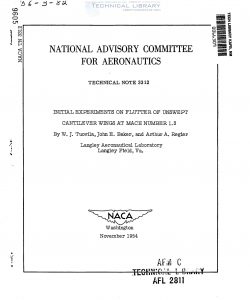naca-tn-3312
- Version
- 118 Downloads
- 656.43 KB File Size
- 1 File Count
- January 23, 2017 Create Date
- January 23, 2017 Last Updated
National Advisory Committee for Aeronautics, Technical Notes - Initial Experiments on Flutter of Unswept Cantilever Wings at Mach Number 1.3

A supersonic tunnel designed to Operate at Mach number 1.5 was used
for a preliminary experimental flutter investigation of widely different
unswept cantilever wings. Data for 12 wings with mass-density parameters
l/n ranging from 52 to 268,'center—of-gravity positions ranging from #6
to 65 percent chord from the leading edge, and elastic—axis positions
ranging from 5h to 52 percent chord from the leading edge are considered.
A comparison is made of the test results with calculations of
bending-torsion flutter obtained by the theory of flutter in supersonic
two-dimensional flow and it is concluded that the test data are in reason-
able agreement with the calculated results. In general, the theoretical
values are conservative. As shown by the theory, the flutter results are
quite sensitive to the location of the center of gravity. Thick and thin,
blunt and sharp airfoil—section shapes were used, but no very pronounced
effect of the section shape on flutter characteristics was found. The
experiments include a study of the effect of the addition of tip moments
of inertia. With the center of gravity of the tip weights coincident
with the center of gravity of the wing section, no detrimental effect on
the flutter speed was found.
The background and theory for the flutter of an airfoil in a two-
dimensional flow at supersonic speeds is given in reference 1. The pres-
ent investigation is a preliminary survey to determine the possibility
of using the theory of reference 1 for flutter at supersonic speeds to
predict the coupled bending-torsion flutter of widely different unswept
cantilever wings at a low supersonic mach number. This preliminary inves— n
tigation is not intended as a critical test of the theory since the analy—_
sis does not consider the effect of mode shape, aspect ratio, section
shape, tip mach cone, or viscous effects.
A single-degree—of-freedom torsional instability which may occur in
the Mach number range 1.0 to 1.58 is discussed in reference 1. In order
also to investigate the possible occurrence of such single-degree flutter
on cantilever wings, the test apparatus was designed to operate at a Mach
number of 1.5.
| File | Action |
|---|---|
| naca-tn-3312 Initial Experiments on Flutter of Unswept Cantilever Wings at Mach Number 1.3.pdf | Download |
Comment On This Post